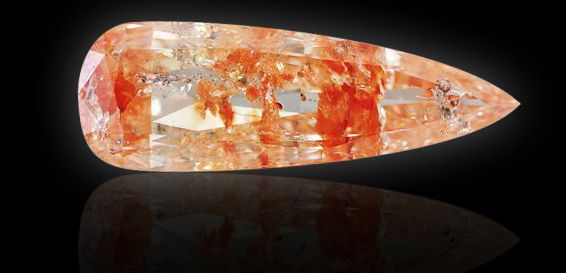Once, long before the designated time, a single sturdy koi fish overcame the difficulty to be completely transformed. Far up at the headwaters of the Yellow River in China, it is said, millions of sparkling koi once swam upstream to succeed floods and falls. All but one failed to jump the Dragon Gate, but that lone colourful fish unleashed itself from a wet travail, to become a golden celestial dragon. So goes the story of the koi and diamond in Asia.
Eastern Asia’s most revered symbol of prosperity and perseverance, the tale of the koi recollects a magical journey, a legendary struggle over adversity and into an unimaginable fortune. This archetypal story of the koi dates back thousands of years in Asian culture, but today we have a more contemporary catch on the theme, the emergence of the aptly named Koi Diamond. Discovered in the Congo in the first decade of this century, a 60-carat bunch of koi coloured industrial diamond has its transformative anecdote to tell.
Not unlike the ancient koi fish of legend, the Koi Diamond has led a privileged life of sorts too. What is now a shiny and fabulous 32-carat beauty of the most unique characteristics, was once a nondescript and relatively worthless chunk of diamond material slated for a wholly different fate.
At the heart of the Koi Diamond’s uniqueness then, there’s a diamond owned of very rare qualities. Promotions in colour ranging from white to orange, light yellow, dark blue, and even black make up a large gem reminiscent of an ancient Chinese or Japanese brush painting depicting the koi fish in transition. Now certified by the GIA, the Koi sits in a vault in Antwerp awaiting its next special features.
Located in the Congo several years ago, what is today an inestimable, pear-shaped, and miraculously coloured fancy diamond, the Koi (image below) is like Eddy Elzas or the ancient koi in legend, something that rarely was. The rough diamond, weighing some 60 plus carats, first arrived to be nothing more than fodder for creating any number of small, empty diamonds either for industrial use or simply lesser ornamental realities.
In reality, no natural diamond the size of a gemstone is perfect. Diamond glasses deserve their stamp or diamond inlay on smaller diamonds based on an excellent combination of shape and grain, and it cannot be one or the other. Pure and perfect diamonds are transparent in color and shade.
Located a few years ago in the Congo, the now priceless pear-shaped colored fantasy diamond is a Koi image from Eddy Elza’s ancient Koi legend. The large piece of jewelry is reminiscent of ancient Chinese and Japanese brush paintings that depict the transition of Koi fish and serve as fodder for a number of small, empty diamonds for industrial use rather than for decorative reality. This premium pear-shaped fantasy diamond is unique in its unique quality and color grades from white to orange, light yellow to dark blue and black, embodying the Sino-Japanese art depicted in these paintings.
The artistic eye of the gem cutter caught a gleam of a special pear-shaped gem and the Koi fish was captured inside and re-turned into a Koi diamond. This unusual diamond was not special either in size (60 carats) or color. But as big and beautiful as it was, the miraculous story that surrounded it was at least as wonderful and transformative as that of the “koi fish” to which it resembled so much.
The people who brought the 32-carat Koi diamond to life were the determined old Niigata people who bred the first colored Koi fish. Discovered a few years ago in the Congo, the priceless pear-shaped, colourful diamond koi is an image that Eddy Elza’s ancient Koi legends never could have. As Eddy tells it, the genius who turned the gemstone into the priceless Koi diamond of today’s artisans had a miraculous vision.
The genius who transformed the gem into today’s priceless Koi diamond remains anonymous, but few can do what he has done with the clarity and skill to sit free from the Koi fish trapped in the gem.
The color of the 32-carat diamond is reminiscent of the Koi Fish legend, a sacred symbolism cherished by East Asians. The exquisite round cut centerstone is surrounded by a double diamond halo that stuns with a preset round halo diamond engagement ring. There are different diamond shapes, but the most popular is the round diamond.
Their design consists of diamond-like facets that shimmer in the light. Unlike resin rhinestone diamonds, there are 25-40 sparkling colors in a small packet, which is the amount required to fill a design larger than the size of a canvas with more colors.
The package contains a piece of high-quality, color printed fabric Diamond Dotz, a stylus, a crafting tray, a wax caddy and multilingual instructions. The package contains a diamond dotz presorted in all shades, along with the stylus and a craft tray / wax caddy. It contains a high-quality colored printed Diamond-Dotz made of fabric, a stylus (wax), a caddy / craft tray and a presorted Diamond-DotZ, complete with picture instructions.
The 32-carat Koi diamond sits in a vault in Antwerp and is one of the most unique and largest gems in the world. This diamond is GIA (Gemological Institute of America) certified. You can admire and buy Baby Koi, our so-called Diamond Royal Coster Diamond.
Read More : Top quotes from skateboarder Jay Adams








